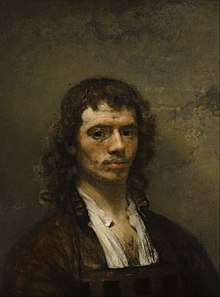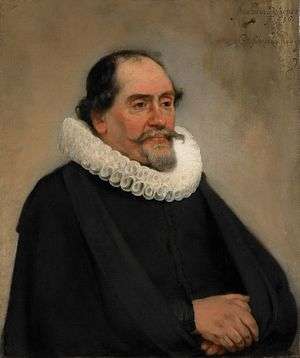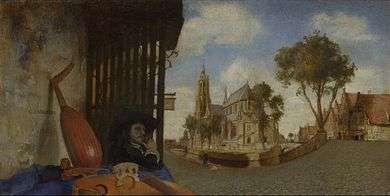Carel Fabritius
Carel Pietersz. Fabritius (Dutch pronunciation: [ˈkaːrəl ˈpitərs faːˈbritsijɵs]; bapt. 27 February 1622 – 12 October 1654) was a Dutch painter. He was a pupil of Rembrandt and worked in his studio in Amsterdam. Fabritius, who was a member of the Delft School, developed his own artistic style and experimented with perspective and lighting. Among his works are A View of Delft (1652), The Goldfinch (1654), and The Sentry (1654).
Carel Fabritius | |
|---|---|
 Self-portrait (c. 1645) | |
| Born | Carel Pietersz. Fabritius baptised 27 February 1622 |
| Died | 12 October 1654 (aged 32) |
| Education | Rembrandt |
| Movement | Delft School |
| Spouse(s) | Agatha van Pruyssen |
Biography
Carel Pietersz. Fabritius was born in February 1622 in Middenbeemster, a village in the ten-year-old Beemster polder in the Dutch Republic, and was baptized on 27 February of that year.[1] He was the son of Pieter Carelsz., a painter and schoolteacher, and he had two younger brothers Barent and Johannes, who also became painters.[1][2][3]
Initially he worked as a carpenter (Latin: fabritius). In the early 1640s he studied at Rembrandt's studio in Amsterdam, along with his brother Barent. In the early 1650s he moved to Delft, and joined the Delft painters' guild in 1652.
Fabritius died young, caught in the explosion of the Delft gunpowder magazine on 12 October, 1654, which destroyed a quarter of the city, along with his studio and many of his paintings. Only about a dozen paintings have survived.[4] According to Houbraken, his student Mattias Spoors and the church deacon Simon Decker died with him, since they were working on a painting together at the time.[4]
In a poem written by Arnold Bon to his memory, he is called Karel Faber.[4]
Painting
Of all Rembrandt's pupils, Fabritius was the only one to develop his own artistic style. A typical Rembrandt portrait would have a plain dark background with the subject defined by spotlighting. In contrast, Fabritius' portraits feature delicately lit subjects against light-coloured, textured backgrounds. Moving away from the Renaissance focus on iconography, Fabritius became interested in the technical aspects of painting. He used cool colour harmonies to create shape in a luminous style of painting.
Fabritius was also interested in complex spatial effects, as can be seen in the exaggerated perspective of A View of Delft, with a Musical Instrument Seller's Stall (1652). He also showed excellent control of a heavily loaded brush, as in The Goldfinch (1654). All these qualities appear in the work of Delft's most famous painters, Vermeer and de Hooch; it is likely that Fabritius was a strong influence on them.

 A View of Delft (1652) exploring an exaggerated, panoramic perspective
A View of Delft (1652) exploring an exaggerated, panoramic perspective The Goldfinch (1654), showing Fabritius' use of cool colour harmonies, delicate lighting effects, and a light background
The Goldfinch (1654), showing Fabritius' use of cool colour harmonies, delicate lighting effects, and a light background.jpg) The Sentry (1654)
The Sentry (1654)_-_National_Gallery%2C_London_-_1654_(2).jpg) Young Man in a Fur Cap, a 1654 self-portrait
Young Man in a Fur Cap, a 1654 self-portrait
List of works
- ca. 1640 The Beheading of John the Baptist, oil on canvas, 149 x 121 cm, Rijksmuseum Amsterdam
- 1643 The Raising of Lazarus, oil on canvas, National Museum, Warsaw
- 1643 The Raising of Lazarus, oil on canvas, Pushkin Museum, Moscow
- 1643/45 Hagar and the Angel, oil on canvas, 157.5 x 136 cm, The Leiden Collection New York
- c. 1644 Portrait of a Seated Woman with a Handkerchief, Art Gallery of Ontario, Toronto
- c. 1645 Self-portrait, oil on panel, 65 x 49 cm, Museum Boijmans Van Beuningen, Rotterdam[5]
- 1645–47 Mercury and Aglauros oil on canvas, 72.4 x 91.1 cm, Museum of Fine Arts Boston
- 1646–1651 A Girl with a Broom, oil on canvas, 107.3 x 91.4 cm, signed as Rembrandt, National Gallery of Art, Washington D.C[6]
- 1649 Portrait of Abraham de Potter, oil on canvas, 68.5 x 57 cm, Rijksmuseum, Amsterdam[7]
- 1652 A View of Delft, with a Musical Instrument Seller's Stall, oil on canvas on panel, 15.4 x 31.6 cm, National Gallery London[8]
- 1654 The Goldfinch, oil on panel, Mauritshuis The Hague
- 1654 The Sentry, oil on canvas, 68 x 58 cm, Staatliches Museum Schwerin Schwerin
- 1654 Young Man in a Fur Cap, oil on canvas, 70.5 x 61.5 cm, National Gallery London (probably a self-portrait)[8]
Notes
- (in Dutch) Carel Fabritius, Netherlands Institute for Art History. Retrieved on 21 August 2014.
- (in Dutch) Barent Fabritius, Netherlands Institute for Art History. Retrieved on 21 August 2014.
- (in Dutch) Johannes Fabritius, Netherlands Institute for Art History. Retrieved on 21 August 2014.
- Karel Fabricius biography in De groote schouburgh der Nederlantsche konstschilders en schilderessen (1718) by Arnold Houbraken, courtesy of the Digital library for Dutch literature
- Self-portrait, Carel Fabritius, c. 1645, Museum Boijmans Van Beuningen. Retrieved on 21 August 2014.
- A Girl with a Broom, National Gallery of Art. Retrieved on 21 August 2014.
- Portrait of Abraham de Potter, Amsterdam Silk Merchant, Carel Fabritius, 1649, Rijksmuseum. Retrieved on 21 August 2014.
- 4 paintings by or after Carel Fabritius at the Art UK site
References
- Carel Fabritius 1622–1654. Het complete oeuvre Frederik J. Duparc, Ariane van Suchtelen, Gero Seelig. ISBN 978-90-400-8987-9
- The Oxford Dictionary of Art ISBN 0-19-280022-1
- Biography at Residenzgalerie Salzburg
- Olga's Gallery
- Adventure's in Cybersound interest in unusual perspectives.
External links
| Wikimedia Commons has media related to Carel Fabritius. |
- Carel Fabritius at Artcyclopedia
- Works and literature on Carel Fabritius
- Vermeer and The Delft School, a full text exhibition catalog from The Metropolitan Museum of Art, which includes material on Carel Fabritius